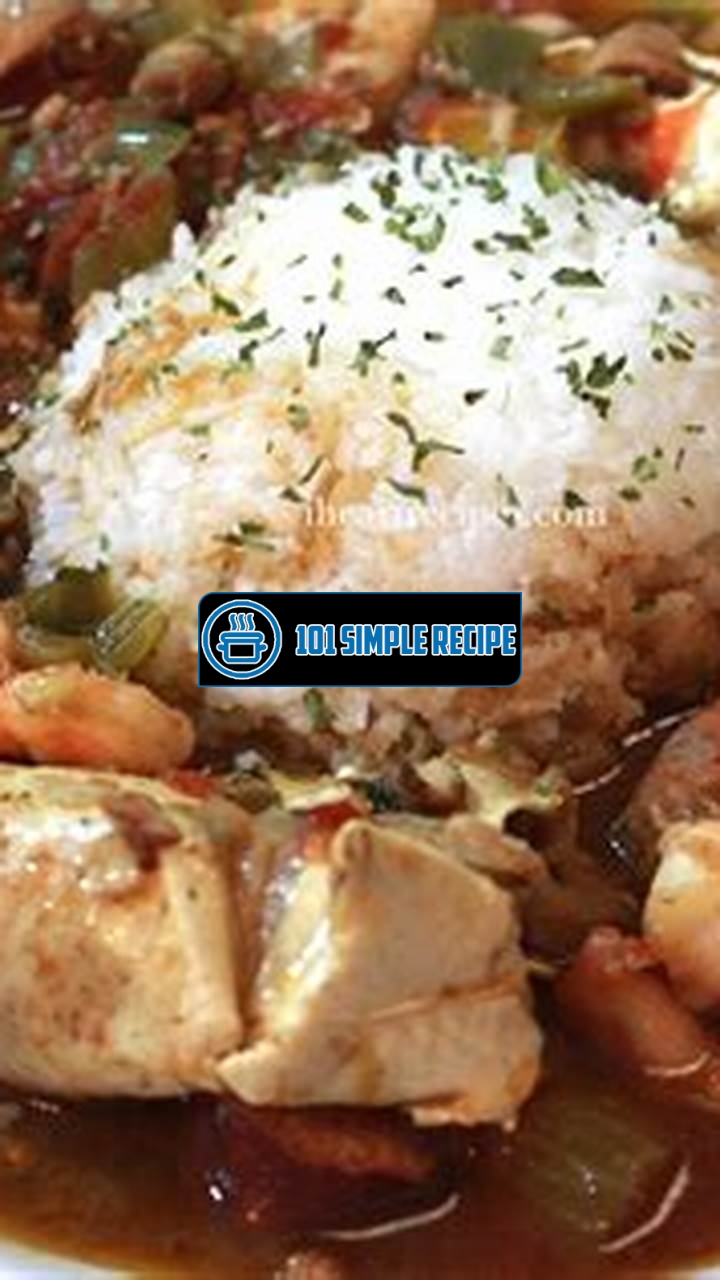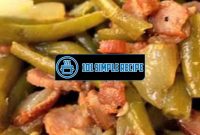Welcome to the world of mouthwatering flavors and comforting warmth with this delicious Chicken and Seafood Gumbo Recipe. Prepared with a savory blend of tender chicken, succulent shrimp, and a medley of aromatic ingredients, this hearty dish will transport you straight to the heart of Louisiana. Whether you’re a seasoned gumbo aficionado or a curious food lover looking to try something new, this recipe is sure to satisfy your cravings and impress your taste buds. So, grab your apron and get ready to embark on a culinary adventure that will leave you longing for more.

What is Chicken and Seafood Gumbo?
Chicken and seafood gumbo is a delightful dish that originates from the southern state of Louisiana, USA. This classic recipe is known for its rich flavor and combination of various ingredients. Gumbo is a type of hearty stew that is typically made with a flavorful stock, meat or seafood, and a variety of vegetables and spices. The dish is traditionally served over a bed of steamed rice, making it a complete and satisfying meal.
The History of Gumbo
The origins of gumbo can be traced back to the cultural melting pot that is Louisiana. It is believed to have been influenced by West African, French, Spanish, and Native American cuisines. Gumbo’s roots can be traced to the 18th century when Louisiana was still a French colony. The dish evolved over time as different cultures brought their own ingredients and cooking techniques to the mix.
Gumbo became a staple in Louisiana’s Creole and Cajun communities. Creole gumbo typically includes tomatoes and is more of a city-style dish, while Cajun gumbo is a rural version that does not include tomatoes. Both variations, however, feature a harmonious blend of flavors and a hearty consistency that is loved by locals and visitors alike.
Key Ingredients of Chicken and Seafood Gumbo
The key ingredients of chicken and seafood gumbo vary slightly depending on personal preference and regional variations. However, some common ingredients include:
- Chicken: The backbone of this dish, chicken adds richness and flavor to the gumbo. It is typically cooked in the stew until tender, resulting in juicy and succulent meat.
- Seafood: Gumbo often includes a variety of seafood such as shrimp, crab, and sometimes even oysters. These seafood elements add a delightful briny flavor and a touch of elegance to the dish.
- Vegetables: Onions, bell peppers, and celery, known as the “holy trinity” of Creole and Cajun cooking, are essential in gumbo. These aromatic vegetables provide a solid base of flavor.
- Spices and Herbs: Gumbo is infused with a blend of spices and herbs like cayenne pepper, thyme, and bay leaves. These ingredients add depth and complexity to the dish.
- Stock or Broth: A flavorful stock or broth forms the base of gumbo. It is typically made by simmering bones, vegetables, and spices for an extended period to extract maximum flavor.
Traditional Cooking Techniques
Preparing chicken and seafood gumbo requires a few traditional techniques to achieve its signature taste and texture. Here are some commonly employed methods:
- Roux: A roux is a mixture of fat (often butter or oil) and flour, cooked until it reaches a rich, nutty brown color. This mixture serves as a thickening agent and imparts a unique flavor to gumbo.
- Filé Powder: Filé powder, made from ground sassafras leaves, is a traditional thickening and flavoring ingredient in gumbo. It is often added towards the end of cooking to enhance the overall taste and texture.
- Simmering: Gumbo is simmered slowly over low heat to allow the flavors to meld together and the ingredients to become tender. This extended cooking time helps develop the dish’s rich flavors.
- Serving: Chicken and seafood gumbo is traditionally served over a bed of steamed rice, allowing the flavors of the stew to mingle with the fluffy grains. The rice absorbs the flavorful sauce and provides a delightful contrast in texture.
Now that you know the origins, key components, and traditional cooking techniques of chicken and seafood gumbo, you can confidently embark on your culinary adventure and enjoy this delicious Louisiana dish.
How to Make Chicken and Seafood Gumbo
Learn step-by-step instructions on how to prepare this flavorful dish in the comfort of your own kitchen.
Preparing the Roux
The first step in making a delicious chicken and seafood gumbo is preparing the roux. The roux serves as the base for the gumbo and provides a rich, thick texture to the dish. Start by heating oil in a large pot over medium heat. Once the oil is hot, gradually add flour, stirring constantly. Continue stirring until the mixture turns a dark brown color, resembling the shade of chocolate.
Note: The process of making the roux requires patience and constant attention to prevent burning. Be sure to stir consistently to achieve a smooth and well-cooked roux.
Adding the Protein: Chicken and Seafood Options
Once the roux is ready, it’s time to add the protein to your gumbo. Chicken and seafood are popular choices for gumbo, as they lend a delicious and savory flavor to the dish. You can either use boneless, skinless chicken breasts or thighs for the chicken portion.
For the seafood options, shrimp and crab are excellent choices. You can use fresh or frozen shrimp, removing the shells and deveining them before adding them to the gumbo. Lump crab meat adds a sweet and delicate taste to the dish.
Note: Feel free to customize the protein options based on your preferences. You can add more chicken, seafood, or even include other meats like sausage or ham to create your own unique gumbo.
Enhancing the Flavors with Vegetables and Spices
The final step in making a flavorful chicken and seafood gumbo is adding vegetables and spices to enhance the taste. Common vegetables used in gumbo include onion, bell peppers, and celery. These aromatic vegetables provide a savory base for the dish.
Add the vegetables to the pot and sauté them until they become tender. This will release their natural flavors and enhance the overall taste of the gumbo. Next, add the spices such as garlic powder, paprika, thyme, and bay leaves. These ingredients will infuse the gumbo with a rich and delicious aroma.
Note: Don’t be afraid to experiment with the spices and add additional herbs or seasonings to suit your taste preferences. Gumbo is a versatile dish that allows for personalization.
By following these step-by-step instructions, you can easily prepare a mouthwatering chicken and seafood gumbo in your own kitchen. The combination of the roux, protein, and flavorful vegetables and spices will result in a satisfying and delicious meal.
Variations and Regional Adaptations
Explore the diverse range of styles and flavors that have emerged in different regions, adding unique twists to the classic gumbo recipe.
Creole Gumbo
Creole gumbo is a popular variation of the classic gumbo recipe that originated in Louisiana. This style of gumbo is heavily influenced by French, Spanish, and West African cuisines, reflecting the cultural diversity of the region. Creole gumbo typically includes a dark roux, which adds a rich and nutty flavor to the dish. It is often made with a combination of meats such as chicken, seafood, and sausage, as well as a variety of vegetables like bell peppers, onions, and celery.
One of the distinguishing features of Creole gumbo is the addition of tomatoes, which lends a slightly tangy and acidic taste to the dish. This ingredient sets it apart from other gumbo variations and gives it a unique flavor profile. Creole gumbo is also known for its use of spices and herbs such as thyme, bay leaves, and cayenne pepper, which add depth and complexity to the dish. The finished gumbo is typically served over a bed of fluffy white rice, allowing the flavors to meld together.
Fun Fact: The use of tomatoes in Creole gumbo is believed to have been influenced by the Italian immigrants who settled in Louisiana. They brought a love for tomatoes and incorporated them into traditional Creole dishes.
Cajun Gumbo
Cajun gumbo is another popular variation of gumbo that originated in Louisiana, specifically in the rural areas and bayous of Acadiana. This style of gumbo is known for its robust and spicy flavors, making it a favorite among those who prefer a kick of heat in their dishes. Cajun gumbo typically does not include tomatoes, unlike its Creole counterpart.
Instead, Cajun gumbo relies on a dark roux for its depth of flavor. The roux is made by cooking flour and oil until it reaches a rich, dark brown color, giving the gumbo a nutty and slightly smoky taste. Cajun gumbo often features a blend of meats such as chicken, sausage, and sometimes duck or game meats like rabbit or alligator. It is also common to find seafood such as shrimp and crab in Cajun gumbo.
️ Hot Tip: Cajun gumbo is known for its spiciness, thanks to the generous use of spices like cayenne pepper, paprika, and black pepper. If you prefer a milder version, you can adjust the amount of spices to suit your taste.
Other Regional Gumbo Specialties
While Creole and Cajun gumbo are the most well-known variations, there are other regional specialties to explore. In the southern parts of Louisiana, you’ll find gumbo z’herbes, a vegetarian version made with a variety of greens such as collard greens, turnip greens, and mustard greens.
On the Gulf Coast of Mississippi and Alabama, you’ll come across seafood gumbo, which showcases the bounty of the Gulf of Mexico. This version typically includes a medley of shrimp, crab, oysters, and sometimes even crawfish.
In the coastal regions of Texas, gumbo is often influenced by Mexican and Tex-Mex flavors. You might find ingredients like chili peppers, cilantro, and even corn in these variations.
Each regional adaptation of gumbo brings its own unique twist to the classic dish. Exploring these variations allows you to experience the rich culinary heritage and diverse flavors of the Southern United States.
Tips for Enhancing the Flavor
Discover expert tips and tricks to take your chicken and seafood gumbo to the next level, ensuring a memorable dining experience.
The Power of Slow Cooking
When it comes to creating a flavorful and hearty gumbo, the power of slow cooking cannot be overstated. Slow cooking allows the flavors of the chicken, seafood, and vegetables to meld together, resulting in a rich and complex dish that is sure to impress. The low and slow cooking process also helps to tenderize the meat and seafood, ensuring a deliciously tender and melt-in-your-mouth texture.
The key to successful slow cooking is to let the gumbo simmer gently over a low heat for an extended period of time. This allows the flavors to develop and intensify, creating a depth of flavor that is unmatched.
✂️ To enhance the flavor even further, consider browning the chicken and seafood before adding them to the gumbo. This step adds a depth of flavor and richness to the dish, elevating it to new heights.
Using Fresh, Local Ingredients
One of the secrets to a truly delicious chicken and seafood gumbo lies in the use of fresh, local ingredients. Using fresh and high-quality ingredients ensures that you are starting with the best possible flavors, which will ultimately translate into a better final dish.
When selecting your chicken and seafood, opt for organic and locally sourced options whenever possible. This ensures that the ingredients are fresh and have been raised in a sustainable and environmentally friendly manner.
Additionally, using fresh vegetables and herbs can make a world of difference in the overall flavor of your gumbo. Fresh herbs, such as thyme, parsley, and bay leaves, add an aromatic and herbaceous note to the dish, while fresh vegetables bring a vibrant and crisp texture.
Balancing the Flavors with Seasonings and Herbs
To create a truly irresistible chicken and seafood gumbo, it is essential to strike the right balance of flavors. This can be achieved through the use of carefully selected seasonings and herbs.
Start by seasoning your gumbo with a mixture of salt, pepper, and other spices such as paprika, cayenne pepper, and garlic powder. This will help to enhance the natural flavors of the chicken and seafood, while adding a subtle kick of heat and complexity.
Herbs, such as thyme, oregano, and bay leaves, can also be added to further enhance the flavor profile of your gumbo. These herbs add a depth of flavor and aroma that will take your dish to the next level.
As with any recipe, it is important to season to taste. Adjust the seasonings as needed, taking into account personal preferences and dietary restrictions.
Note: Following these expert tips and tricks will surely help you create a chicken and seafood gumbo that is bursting with flavor and guaranteed to impress your family and friends. Happy cooking!
Pairing Suggestions
When it comes to enjoying a hearty and flavorful dish like chicken and seafood gumbo, it’s important to have the perfect accompaniments that will enhance the overall meal and create a truly delightful culinary experience. Whether you prefer traditional rice pairings, bread selections, or beverage recommendations, there are plenty of options to choose from that will perfectly complement this rich and savory dish.
Traditional Rice Pairings
One of the classic and authentic ways to serve chicken and seafood gumbo is by pairing it with a bed of fluffy and fragrant rice. The combination of the tender meat, flavorful seafood, and the robust gumbo sauce melting into a bed of perfectly cooked rice creates a harmonious blend of flavors. White rice is the most popular choice for this pairing, as it acts as a neutral base that allows the gumbo to take center stage. However, you can also opt for other varieties such as jasmine rice or long-grain rice to add a subtle aromatic touch to the dish.
Tip: To ensure that your rice complements the gumbo perfectly, try cooking it with chicken or seafood broth instead of water. This will infuse the rice with additional flavors that will complement the gumbo.
Bread Selections to Complement the Dish
Another fantastic way to enjoy chicken and seafood gumbo is by pairing it with a selection of delicious bread. The crusty texture, warm interior, and flavors of freshly baked bread provide a satisfying contrast to the hearty gumbo. There are several options to consider when it comes to choosing the right bread:
- French Baguette: Sliced and lightly toasted, a French baguette is a classic choice that adds a rustic and crunchy element to each bite.
- Cornbread: The slightly sweet and crumbly texture of cornbread is a popular choice in Southern cuisine and pairs exceptionally well with the rich flavors of gumbo.
- Sourdough: The tangy flavor and chewy texture of sourdough bread provide a unique twist to the traditional pairing, creating a delightful blend of tastes and textures.
Tip: Consider serving a variety of bread options to cater to different preferences and to provide a range of flavor profiles that can be enjoyed with the gumbo.
Beverage Recommendations
No meal is complete without a refreshing beverage to wash it down. When it comes to pairing beverages with chicken and seafood gumbo, you have several options that can enhance the flavors and provide a satisfying contrast. Here are a few recommendations to consider:
- Beer: A cold and crisp beer, such as a lager or a pale ale, can help cleanse the palate and cut through the richness of the gumbo.
- Wine: For those who enjoy wine, a light-bodied red wine, such as a Pinot Noir or a Beaujolais, can complement the flavors of the gumbo without overpowering them.
- Iced Tea: A classic Southern beverage, iced tea, whether sweetened or unsweetened, can provide a refreshing and cooling effect that perfectly balances the warmth and richness of the gumbo.
Tip: Don’t forget to offer non-alcoholic options, such as sparkling water or fruit-infused water, to cater to those who prefer a non-alcoholic beverage or to provide a refreshing alternative.
In conclusion, when it comes to serving chicken and seafood gumbo, the right accompaniments can elevate the meal to new heights. Whether you choose traditional rice pairings, bread selections, or beverage recommendations, there are endless possibilities to explore and create a delightful culinary experience. So, be creative, experiment with different pairings, and enjoy the symphony of flavors that unfold with every bite.
Thank you for taking the time to read our article about chicken and seafood gumbo. We hope you found it informative and inspiring for your next culinary adventure. If you’re craving a warm and delicious meal, remember to revisit this recipe for the perfect gumbo experience. Whether you’re a seafood enthusiast or a lover of flavorful chicken, this dish is sure to satisfy your taste buds. So, get your ingredients ready, put on your chef hat, and let’s start cooking!
Frequently Asked Questions
Here are some frequently asked questions about chicken and seafood gumbo:
| No. | Questions | Answers |
|---|---|---|
| 1 | What is gumbo? | Gumbo is a traditional Louisiana dish that combines a variety of ingredients such as meat, seafood, and vegetables in a flavorful broth thickened with roux. |
| 2 | Can I use frozen seafood for gumbo? | Yes, you can use frozen seafood for gumbo, just make sure to properly thaw it before adding it to the dish. Fresh seafood is also a great option if available. |
| 3 | How long does gumbo take to cook? | Gumbo typically takes around 2 to 3 hours to cook, allowing the flavors to meld together and the ingredients to become tender. |
| 4 | What can I serve with gumbo? | Gumbo pairs well with rice, cornbread, or crusty French bread. You can also serve it with a side salad for a complete meal. |
| 5 | Can I freeze gumbo? | Yes, you can freeze gumbo for future meals. Just make sure to store it in an airtight container and thaw it properly before reheating. |
| 6 | Can I adjust the spice level of gumbo? | Absolutely! You can adjust the spice level of gumbo by adding more or less Cajun seasoning, chili powder, or hot sauce according to your preference.
A Taste of Louisiana: Chicken and Seafood GumboIn conclusion, we hope our article has sparked your interest in trying out the delicious and comforting chicken and seafood gumbo. With its rich flavors, tender meats, and tantalizing aroma, this dish is a true culinary masterpiece. So, put on your apron, gather your ingredients, and dive into the world of Cajun cuisine. Don’t forget to share your gumbo creations with friends and family for a memorable dining experience. Thank you for reading, and we can’t wait to have you visit us again for more gastronomic delights! Jump to RecipeChicken and Seafood Gumbo Enjoy a taste of Louisiana with our flavorful chicken and seafood gumbo recipe. This savory dish combines tender chicken, fresh seafood, and a blend of aromatic spices for a delightful culinary experience.
|







